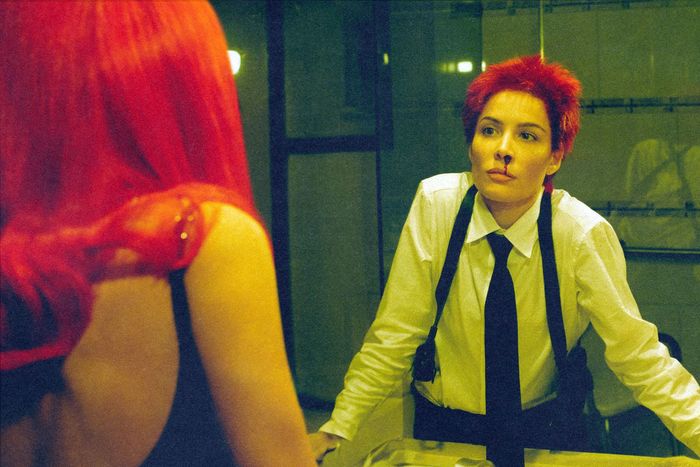
Comparing the rollout of Halsey’s new album The Great Impersonator to the actual music is the most recent example of the “what I ordered versus what I got” meme. In the weeks leading up to its release, the pop star shared pictures of herself dressed like the artists you’d find in a cool mom’s CD wallet. Each was named as an influence on a new track: Halsey as Linda Ronstadt, as Fiona Apple, as Aaliyah.
Since her 2014 EP Room 93, Halsey’s career has been dotted with the kind of ubiquitous smashes (“Without Me,” “Closer”) and ambitious fare (2021’s If I Can’t Have Love, I Want Power) these same musical heroes have produced in spades. The Great Impersonator goes in a different direction. It’s a clear and exacting demand to be taken seriously on her own terms, making the costuming stunt all the more discordant.
The bulk of references on Impersonator are cosmetic at best. “Letter to God (1983)” and “Panic Attack” have little to do with their supposed influences — Bruce Springsteen and Stevie Nicks, respectively — other than sharing rhythmic similarities to “Dancing in the Dark” and “Dreams.” Halsey claims Tori Amos for “Life of the Spider” simply because it’s a solo piano track. David Bowie is tapped for “Darwinism” apparently because there’s some outer-space imagery. Cher, Kate Bush and Björk are inspirations for God knows why on “Letter to God (1974),” “I Never Loved You,” and “The Great Impersonator.” The most egregious example is Joni Mitchell for “The End,” when album opener “The Only Living Girl in LA” would have made more sense as a tribute — not because it sounds like Mitchell, but because it includes long strings of verses without a chorus and an over-it approach to celebrity she perfected. Only two beloved artist callouts make real sense: Britney Spears, whose “Lucky” is interpolated on Halsey’s fame-weary song of the same name, and Dolly Parton, whose twang is approximated on “Hometown,” a chipper highlight about dying young,
Despite the misalignment of image and sound, Halsey’s cosplaying puts her in good company. Celebs dressing up as celebs is so hot right now. Zendaya showed up to this year’s Rock and Roll Hall of Fame induction ceremony looking like Cher in a Bob Mackie gown, while Sabrina Carpenter arrived at the VMAs also wearing a Mackie — the same one Madonna had on at the 1991 Oscars. Both commanded attention that they might not have in more conventional contemporary digs. Halsey’s looks received pick-up too, the kind her corresponding songs haven’t.
But Halsey is plenty idiosyncratic on her own, so even when she’s doing PJ Harvey’s quiet-to-loud flareup on “Dog Years,” she still sounds like Halsey. It’s like the rollout was one big misdirection to promote a Halsey album that is obsessed with Halsey. On Impersonator, she sings of her fraught relationship with fame; her love for her son, Ender; her broken relationship with her father; and her illness. (In June, she announced that she had been diagnosed with lupus and a T-cell lymphoproliferative disorder — these in addition to several previous diagnoses, including endometriosis and Ehlers-Danlos syndrome.) On social media, she said that she “made this record in the space between life and death,” and it shows. All but two of the standard edition’s 18 songs refer to dying either explicitly or by implication.
“Quite frankly, to be alive / It shouldn’t kill me every day, the way it does,” she sings in “The Only Living Girl in LA.” But it’s again clouded by its stated inspiration. For an artist who compared this song to Marilyn Monroe, it sounds like Poe, and the prominent alterna-’90s revivalism thread that runs through Impersonator hews closer to beabadoobee or Olivia Rodrigo than anyone she referenced. There are unique nuances here and there — “Darwinism” surrounds a piano ballad with spacey ambiance, the beat of “Hurt Feelings” flickers before a muffled bass drum takes over — but this is a sonically conservative record that’s not as adventurous or synthy as past Halsey.
Yet, in maybe the biggest twist of a project that was marketed via cosplay, we are also left with a better sense of who Halsey is now. Her storytelling has never been clearer, nor has her ability to turn out a great line. She is particularly crafty with irony, from the downside of having an O-negative blood type (“I can give to anyone in need / But only receive from someone exactly like me”) to the decades-long ramifications of negligent parenting (“You didn’t chase me through the park / So now I’m chasin’ after you”). Rather than a jukebox of references, The Great Impersonator is instead rattled by the obligations of pop stardom. On the title track, she mulls hiding her true self while revealing that she is lonely, kind, and “scared that I can’t hack it with the current paradigm.” We’re left with the impression that it’s hard enough being Halsey. Those pictures of her dressed up like other artists were the easy part.

